The Calhouns Acquire Long Cane Land, 1758
After their arrival on the Long Cane in February 1756, the Calhouns petitioned for title to the land on which they had settled. Robert Meriwether explains this step in their settlement process in detail:[1]
In September of [1756] certain settlers of the Long Canes region petitioned the governor for protection against Cherokee depredations, saying that they had moved from the Virginia frontier at the beginning of the preceding year, and had secured the consent of the Cherokees for their settlement. Applications for warrants, however, were not made until June 6 1758, when William, Ezekiel and Patrick [Calhoun] were allowed four hundred, five hundred and two hundred acres respectively, while Arthur Patton, doubtless also from Augusta County, was given a warrant for six hundred and fifty acres. On the fourth of July Mary Noble applied for three hundred acres and James Calhoun for three hundred and fifty; in November Robert Norris, apparently another neighbor from Virginia, and Hugh and Robert Calhoun were given warrants for three hundred, a hundred, and a hundred acres respectively. Patrick evidently had secured a deputation as surveyor while in Charleston and with these tracts began the near monopoly of Long Canes surveying which he held for seven years. William had his plat surveyed to include Little River immediately above its junction with a small stream later known as Calhoun Creek. Perhaps the preference was given to Mary Noble, who acquired “Cane Hill” at the junction of the forks of Calhoun Creek, a mile above her brother. Patrick laid out his own land on the south fork of the creek a mile beyond Cane Hill.
Meriwether is citing South Carolina Council Journal minutes for 6 June 1758. Council minutes for that date show Ezekiel Calhoun petitioning for two tracts of land on Long Cane, one a tract of 150 acres, the other a tract of 350 acres.[2] These are the 500 acres about which Meriwether is speaking above.

With the warrant issued on 6 June 1758, Ezekiel’s brother Patrick Calhoun surveyed his 350 acres on 7 July 1758.[3] The plat states that the tract was on the northwest fork of Long Cane in Granville County and was called Spring Hill, and that it bordered on a survey for Henry Baker.
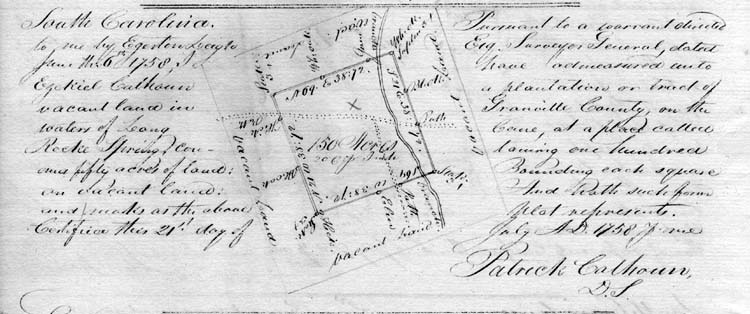
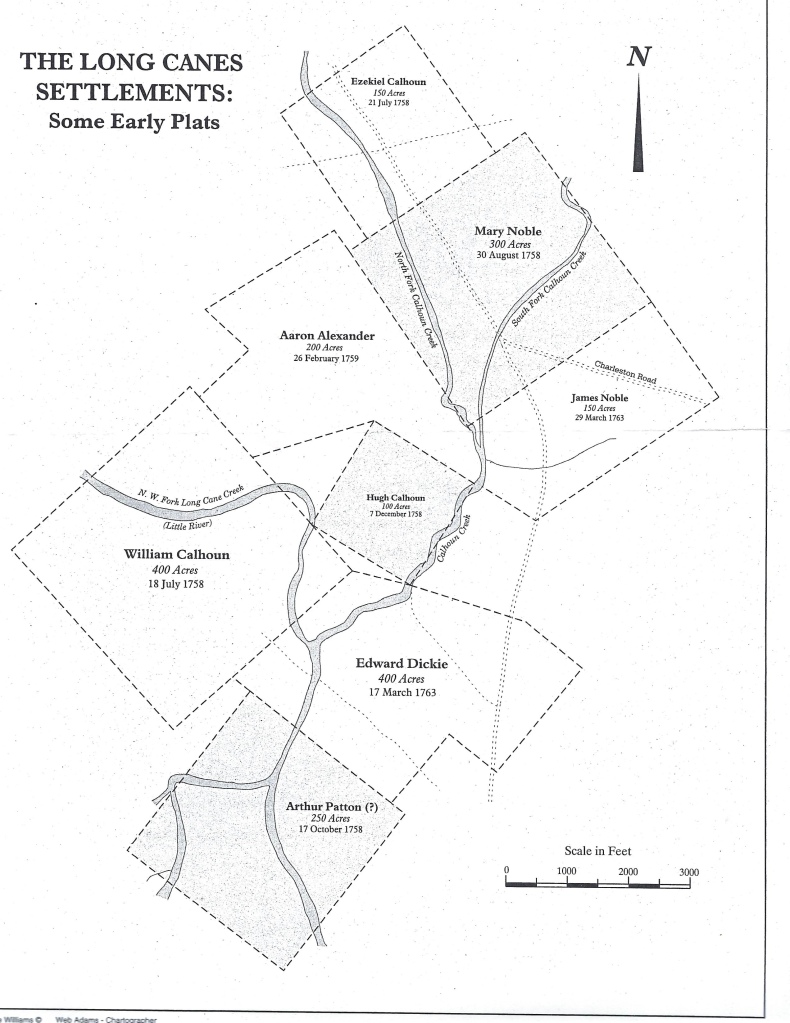
On 21 July 1758, Patrick Calhoun surveyed the 150-acre tract for Ezekiel. The plat states that the land was on the waters of Long Cane in Granville County at a place called Rock Spring.[4] In an article entitled “The Calhoun Settlement in the Long Canes, Abbeville, South Carolina, 1756-1760,” researcher Rose-Marie Williams shows the location of the Rock Spring plat in its relation to other plats issued to the early Long Cane settlers.[5] Ezekiel’s 150-acres were bordered on the south by the 300 acres surveyed for his sister Mary Noble on 10 August 1758 — the Cane Hill tract of which Meriwether speaks above — and were just up the north fork of Calhoun Creek from 100 acres surveyed for Hugh Calhoun and 400 acres on the northwest fork of Long Cane (i.e., Little River) surveyed for Ezekiel’s brother William Calhoun.


Grants were made for both of Ezekiel’s pieces of land on 22 January 1759.[6] Memorials for the two tracts were recorded on 19 March 1759.[7]
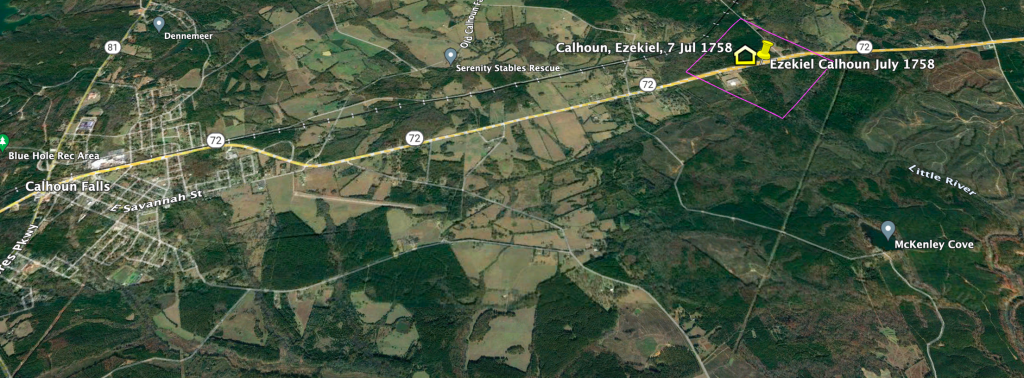
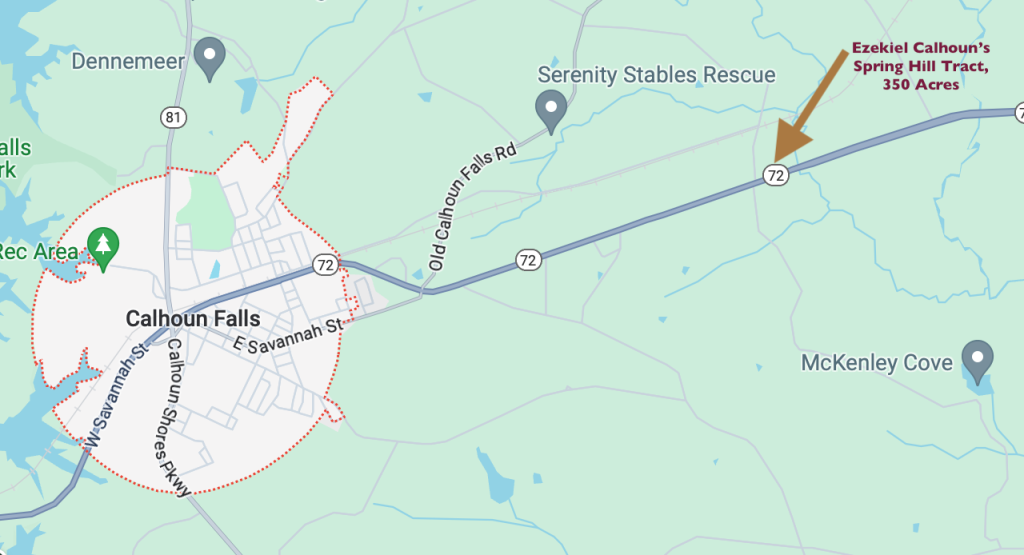

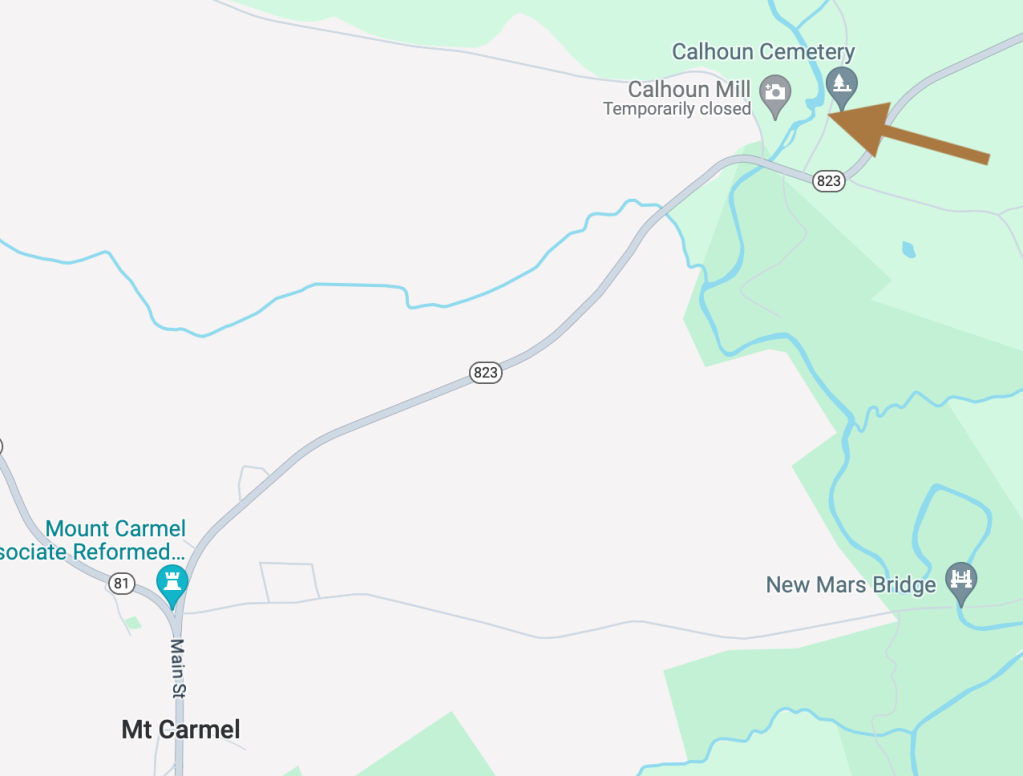

Ezekiel’s Spring Hill tract of 350 acres was not far east of the present-day town of Calhoun Falls in Abbeville County, immediately east of the junction of county road S-1-163 (also called McKenley Creek road) and highway 72. The land lay on both sides (north and south) of highway 72. The Rock Spring tract of 150 acres is in present-day McCormick County, just south of the Abbeville County line and just northeast of Mt. Carmel. The land lies between Calhoun Mill and Calhoun cemetery, immediately west of county road S-33-134, and between that roadway and Little River. Highway 823 runs not far south and east of this locale.
The Long Cane Massacre, 1 February 1760
Ezekiel got title to his two tracts of land in the Long Cane settlement in January 1759, and then in February the following year — 1760 — calamity stuck with what’s called the Long Cane massacre that occurred on the 1st of February 1760. As noted in the previous posting, tensions had been building for some time between the Cherokees to the west and the new settlers in the South Carolina upcountry, particularly those in the Long Cane settlement, who were living not far from Cherokee territory. In 1759, Cherokees killed several British traders and upcountry settlers in the northwest part of South Carolina. Refusing to meet a delegation of Cherokee leaders who sought peace with South Carolina after this, Governor William Henry Lyttleton led a military foray into the upcountry and took the leaders hostage. He then negotiated a treaty with the Cherokees — who were obviously under duress as they negotiated — and when a number of Cherokee leaders refused to accept the terms of the treaty, conditions for war had been created.[8]
Receiving word of an imminent attack, the Long Cane settlers assembled at Hopewell church, according to Lester Ferguson, who says that a legend maintains that a Cherokee woman rode on horseback to the settlement to warn of the coming attack.[9] The settlers then set out for Tobler’s fort on the east side of the Savannah River from Augusta, Georgia, but wet conditions caused them to stall, and they were laid upon by Cherokee warriors. Twenty-three Long Cane settlers were killed, including the matriarch of the Calhoun family, Catherine Montgomery Calhoun, aged 74, her son James Calhoun (and, according to some but not all sources, his wife Nancy), and William Calhoun’s daughters Catherine. William’s daughter Ann was taken into captivity and later found, bought from captivity, and returned to her family. Some sources report that Ann’s sister Mary also died in the massacre, but in a memoir she wrote prior to her death in 1830, Ann states that she once saw Mary at a Green Corn dance in the Cherokee Nation after they were both taken captive, but was prevented from approaching her sister.
I have not found any account of the Long Cane massacre which explicitly states that Ezekiel Calhoun was among those fleeing the settlement for safety in January 1760, but I assume that he and his family were among those who experienced the Cherokee attack, since the letter of Francis Wilkinson Pickens, grandson of Andrew Pickens and Rebecca Calhoun, to Charles H. Allen on 26 March 1848, which the previous posting discusses, states,[10]
After that massacre in 1761 [sic], Ezekiel Calhoun fled to the Waxhaws, the nearest white settlement, for protection.
My grandfather lived there, and then got acquainted with my grandmother, who was the daughter of Ezekiel Calhoun, and came back to the Calhoun’s settlement with them, and married there.
According to Bobby Edmonds, Ezekiel’s daughter Rebecca was found hiding in the woods when her uncle Patrick Calhoun returned to the site the day after the massacre occurred.[11]
Prior to the Long Cane massacre, Ezekiel Calhoun had made his will on 3 September 1759.[12] I’ll discuss the will in detail later. I suspect Ezekiel made this will in September 1759 because he was making plans to return to Virginia to look after his land there, and, given the precariousness of travel to the western frontier of Virginia in that troubled period, he wanted to set his affairs in order before he traveled. The will also states that Ezekiel was “weak of Body” when he made the will, so perhaps he had developed serious health problems at this point in his life, and for that reason returned to Virginia to set his affairs there in order. Since Ezekiel was apparently still on the Long Cane when the Cherokee attack took place in February 1760 and then took his family to the Waxhaws for safety, his trip to Virginia must have taken place at some point after the family went to the Waxhaws.
Ezekiel Returns to Augusta County, Virginia, on Business, 1761, and Is Killed and Buried There in 1761 or 1762
We learn that Ezekiel returned to Augusta County, Virginia, and was killed by an unknown assailant while he was there from an account compiled by Arthur Meaux Kent of Wytheville in 1970 entitled “Ezekiel Calhoun and Kenton,” which is archived in the John C. Calhoun Papers at South Caroliniana library in Columbia.[13] Kent’s account states that “by 1762,” Ezekiel Calhoun returned to his Reed Creek land in Virginia without his family and presumably on business, and while he was staying in a cabin on the land, he was shot and killed as he stood in the door of the cabin, with a “lone Indian” thought to have been the assailant.[14]
Ezekiel was then buried south of the spring on his former plantation, and in 1970, a flat stone with no inscription still marked the grave. Arthur Kent states that in the summer of 1969, he had taken Mary B. Kegley and Mrs. Louis Hill of Gonzales, Texas, to the site and shown them the grave marker. He notes that when Ezekiel’s son John Ewing Colhoun sold the Reed Creek land in 1771 to Montgomery cousins, they lived on the farm and preserved these traditions regarding how Ezekiel died and where he was buried, and then they passed this information on to Arthur Kent’s family, who obtained possession of the land after the Montgomerys sold it to George Hancock, who traded it for land owned by Arthur Kent’s grandfather Joseph Kent. Arthur Kent writes,
The Montgomerys were living at the time of Col. Joseph Kent’s arrival [on Ezekiel Calhoun’s Reed Creek farm] and they passed the traditions along. The Kent family through Gordon Cloyd Kent, son of Col. Joseph, through his son Joseph Gordon Kent and his grandson Arthur Meaux Kent kept the traditions alive. All of these Kents resided on the Kenton plantation and were well acquainted with the graveyard and the cabin and the circumstances of Calhoun’s death.
In 1782, Joseph Kent was living on Ezekiel Calhoun’s former plantation when George Hancock bought the land from the Montgomerys. Kent built a brick mansion on the land and named it Kenton. Arthur Kent’s account states that he compiled his account “in order to preserve the traditions [regarding Ezekiel Calhoun’s death and place of burial] known to the Kent family.”
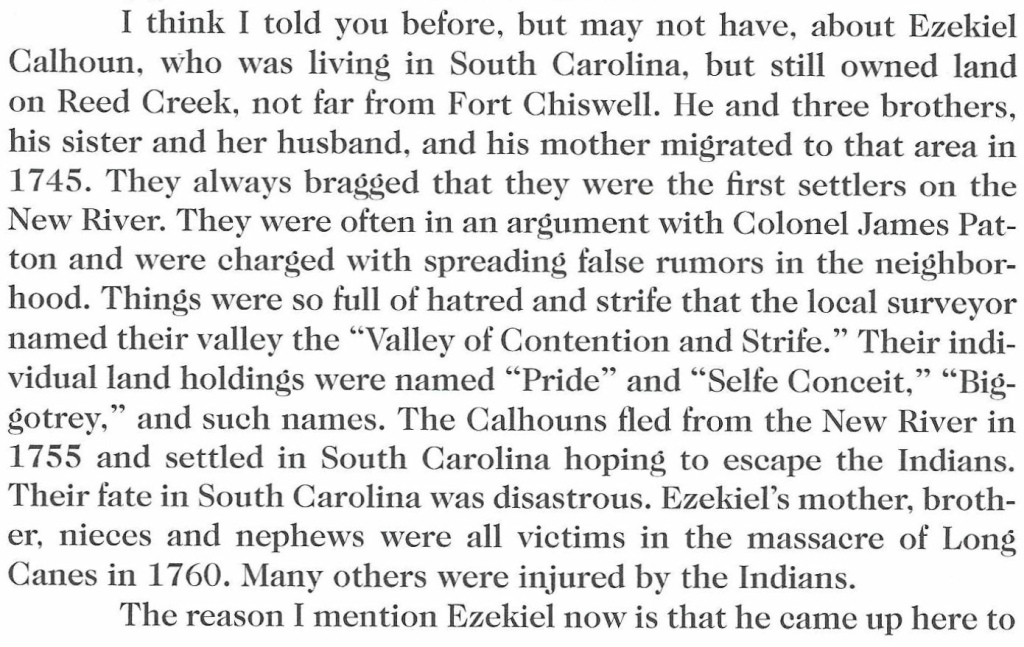
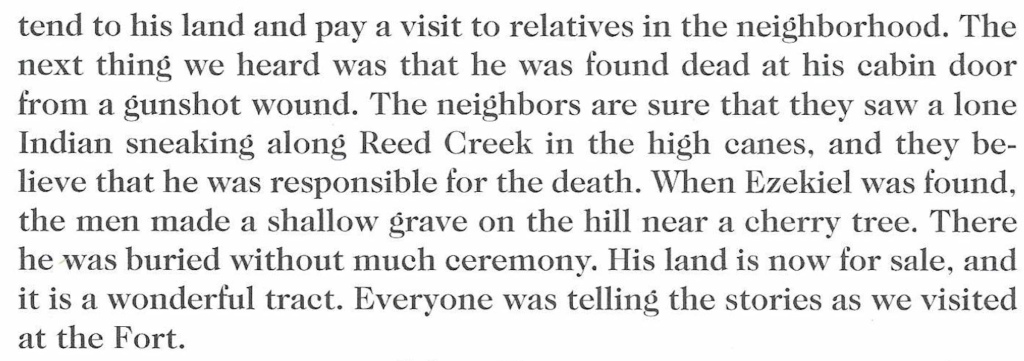
In emails to me on 24 and 26 June 2002, Mary B. Kegley told me that the grave of Ezekiel Calhoun is on a farm located behind the headquarters of a division of the Virginia state police on Reed Creek. Mary Kegley also noted that Ezekiel’s grave had been marked by Mrs. Louis Hill, a descendant of Ezekiel Calhoun, with a metal marker some years ago, and she states that Arthur Kent took her and Mrs. Hill to Ezekiel’s grave site site under a large cherry tree on a hill overlooking the spring. It was apparently at this time that Mrs. Louis Hill, who was multiply descended from the Calhoun family, marked the site with a metal marker she nailed to the cherry tree, stating that this was the site of Ezekiel Calhoun’s burial and recording the dates 1720-1762.[15] Mary Kegley offered to show me the burial site if I had the opportunity to come to Wytheville.
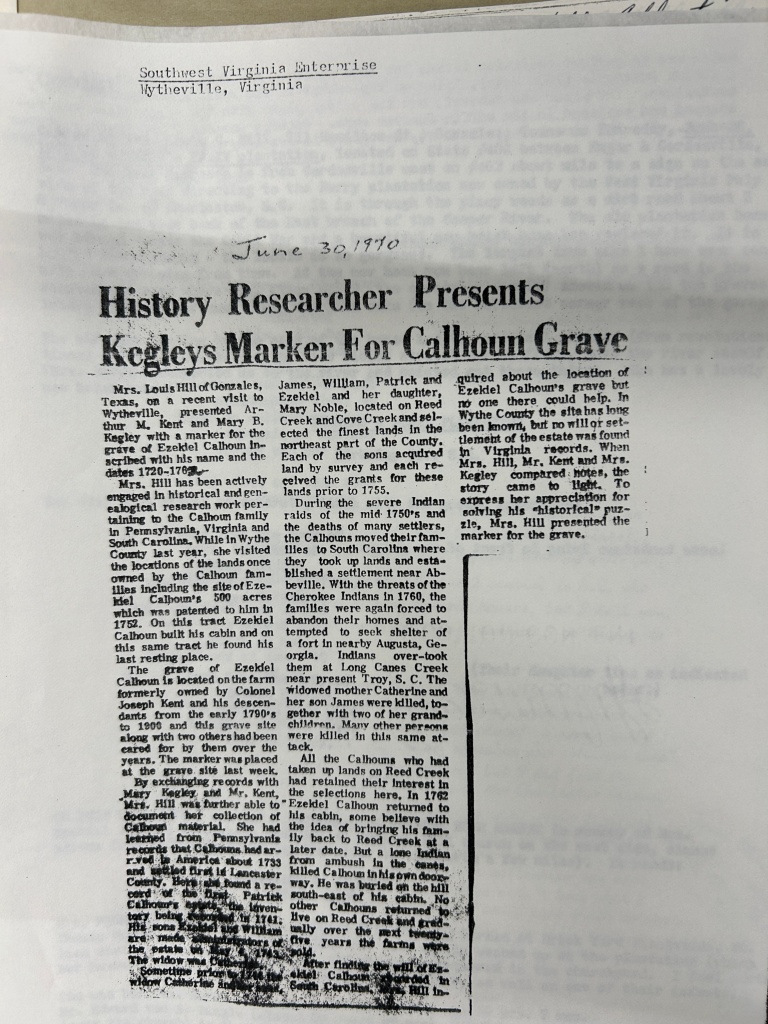
An article in Southwest Virginia Enterprise on 30 June 1970 entitled “History Researcher Presents Kegleys Marker for Calhoun Grave” reports on Mrs. Louis Hill marking the grave of Ezekiel Calhoun, and about the site of Ezekiel’s grave on his land in Wythe County that passed to the Kent family. The article states that Mrs. Hill presented Arthur M. Kent and Mary B. Kegley with a marker for the grave on a recent visit to Wytheville. The article also recounts the circumstances of Ezekiel’s death as this information had passed down in the Kent family. A copy of this article is preserved in the “Calhoun, Noble, and Pickens Families Collection” of Clemson University Library’s Special Collections and Archives (box 1, mss 225).
Ezekiel Calhoun’s Will
Ezekiel’s will (see the image at the head of the posting) reads as follows:
In the name of God Amen I Ezekiel Calhoun of the province of South Carolina & County of Granville being weak of Body but sound of Memory Blessed be God do this day vizt the third of September in the year of our Lord God 1759 make and Publish this my last will & testament in manner following (that is to say) first I give to my son John Calhoun my gun & Saddle and the Bald faced horse & I also bequeath to my dear wife Jean Calhoun the thirds of all my goods & Chattels and personal Estate whatsoever except my lands I also allow an equal division to be given of the Rest and Remainder of all my Goods and Chattels & personal estate whatsoever to my son John Calhoun Patrick Calhoun Ezekiel Calhoun & likeways to my Daughter Mary Calhoun Rebecca Calhoun Cathren Calhoun Jean Calhoun also I give all my lands I claim & possess upon Long Canes with all my Pattan Lands at Reed Creek being in the Colony of Virginia and County of Agusta [sic] to my three Sons above named to be Equally divided to each one of them I also allow to my dear Wife Jean Calhoun when the lands are valued & divided her third part thereof in money as in the Lands, which they shall see Cause to give & I likeways allow each one & every one of my four Daughters above named their Equal parts with my sons vizt of the value of all my Lands when they are Valued and divided, either in money or the Lands which my sons shall choose I likeways allow my dear wife above to have the management of all the Plantation I now dwell upon and the Care of all the children in her own hands while unmarried according to the Intent of this will but if married as the Exor shall see cause or think proper that she shall remain there or not any Longer, I also if my wife now proves with child whether it be Son or Daughter shall have an Equal division as one of my Sons or Daughters aforesaid and in like manner as aforesaid and I make & ordain her my said Wife Executrix & my brother Patrick Calhoun Exor of this my will in Trust for the Intents & purposes in this my will contained & I make my two Brothers James Calhoun and William Calhoun Overseers of this my will to take care & see the same performed according to my true Intent & meaning In Witness whereof I the said Ezekiel Calhoun have to this my last Will & Testat set my hand & seal the day and above written.
Signed sealed & delivered by the said Ezekiel Calhoun as and for his Last Will and Testament in the presence of us who were present at the signing
Ezekial Calhoun {LS}
Alexander Noble
John Wilson
Robert Norris
Proved by Virtue of a Dedimus before Thos Bell Esq the Twenty fifth Day of May 1762 at the same time qualified Patrick Calhoun & Jean Calhoun as Exor & Executx
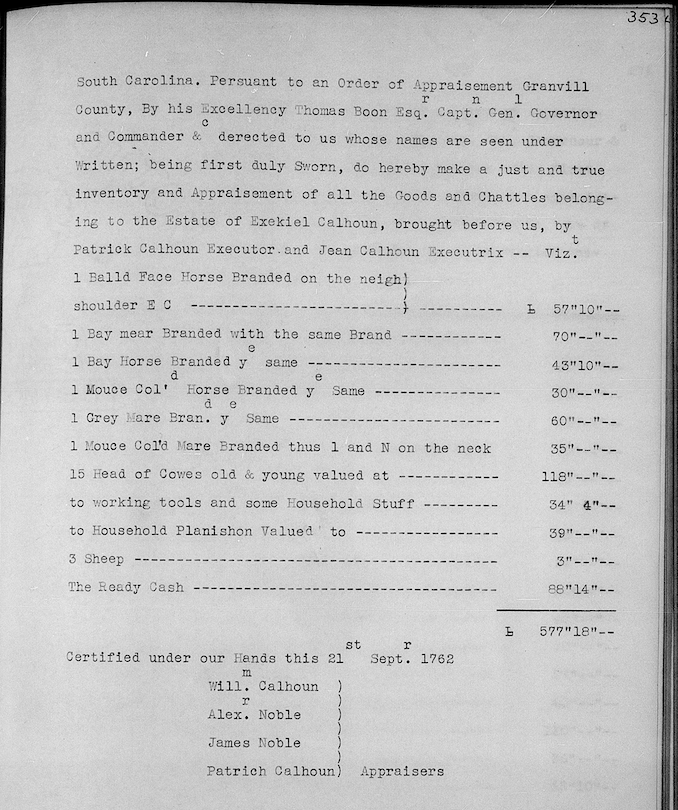
On 21 September 1762 Ezekiel’s brothers William and Patrick Calhoun with their nephews Alexander and James Noble inventoried Ezekiel’s estate for executors Patrick Calhoun (Ezekiel’s son) and Jean Calhoun.[16] The inventory shows an estate valued at £577 18s, with six horses, fifteen head of cattle, three sheep, tools and household goods, and ready cash amounting to £88 pounds 14s. On the same day that Ezekiel’s estate was inventoried, the same appraisers including Patrick Calhoun inventoried the estate of Ezekiel’s brother James, who was killed in the Long Cane massacre on 1 February 1760 James’s inventory is on the page following Ezekiel’s in the inventory book, with his estate valued at £657.16.8.
As John C. Calhoun’s November 1847 letter to Charles H. Allen cited in the previous posting states, following Ezekiel Calhoun’s death, his widow Jane/Jean Ewing Calhoun married a Norris. This was Robert Norris, whose wife Elizabeth Wrentz Norris was among those killed in the Long Cane massacre.
Ezekiel’s Son John E. Colhoun Sells the Reed Creek Land in Virginia, 1771
On 5 September 1771, Ezekiel’s son John Ewing Colhoun sold Ezekiel’s Reed Creek tract of 500 acres, which had fallen into Botetourt County when that county was formed from Augusta in 1770, to his cousin Robert Montgomery.[17] The deed states that John Calhoun was living in Granville County, South Carolina, and Robert Montgomery in Botetourt County, and that John Calhoun sold the land to Robert Montgomery for £280. The deed was signed by John Calhoun with witnesses William Preston, Ephraim Dunlap, Samuel Crockett, James Montgomery, and James McGavock. On 8 October at Botetourt County court Ephraim Dunlap, James Montgomery, and James McGavock proved the deed.
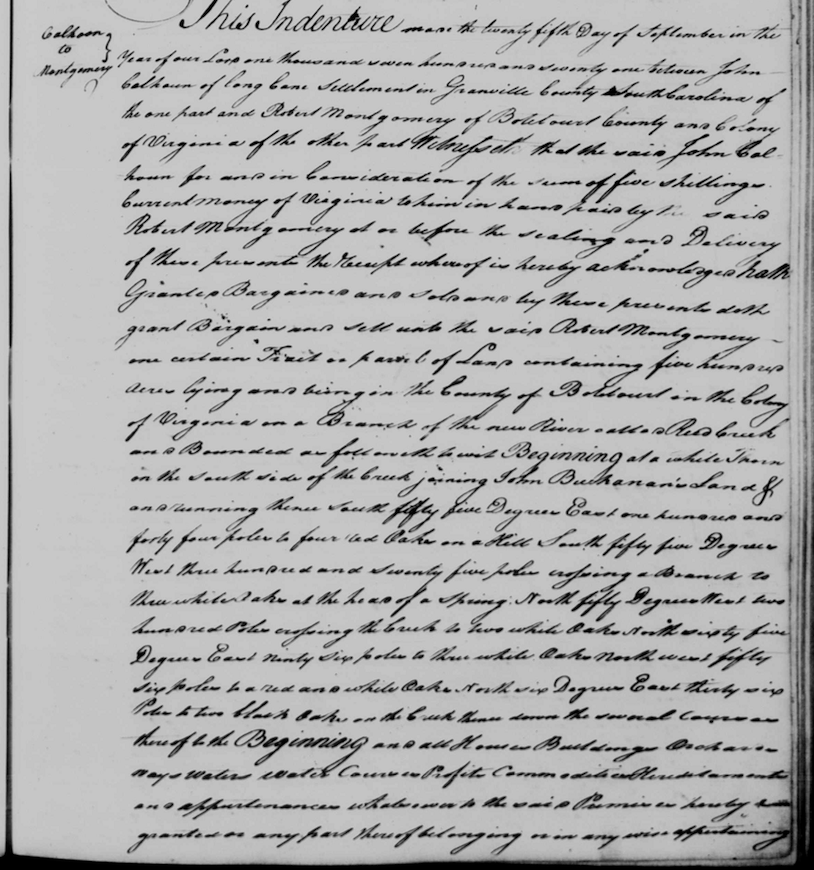
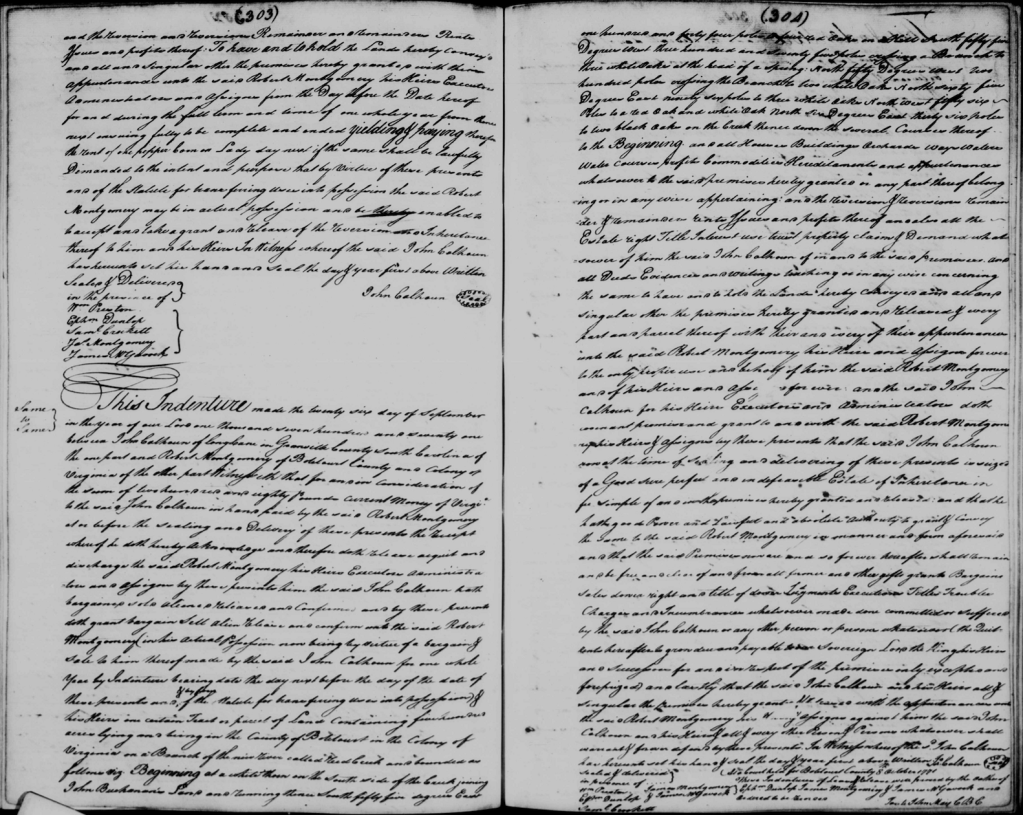
Mary B. Kegley states that Robert Montgomery was born about 1717 in County Donegal, Ireland, and came to America about 1733, evidently along with his Montgomery and Calhoun relatives. He settled first in Lancaster County, Pennsylvania, and by 1746, was in Augusta County, Virginia, where by 1773 he had moved to Reed Creek in what’s now Wythe County.[18] Robert Montgomery’s father was, Kegley indicates, a James Montgomery who was born about 1690 in County Donegal and who died in Augusta County, Virginia, before 19 November 1756. James Montgomery was, according to Kegley, a brother of Ezekiel Calhoun’s mother Catherine Montgomery Calhoun, and appears to have come to Lancaster County, Pennsylvania, with the Calhoun family and from there to Augusta County, Virginia, after the Calhouns relocated there. As we saw in the last posting, when John C. Calhoun wrote Ezekiel Calhoun’s grandson James Edward Calhoun on 15 September 1846 to tell James Edward about his recent trip to Wytheville, he stated that the Montgomerys were then in possession of lands the Calhouns had owned in Wythe County, and that they were “connected with us.”
Kegley states that, soon after buying it, Robert Montgomery sold Ezekiel Calhoun’s Reed Creek land to William and James Montgomery, and, as discussed above, from them it went via George Hancock to the Kent family who built their Kenton house on the land.
John E. Colhoun Sells Ezekiel’s Rock Spring Tract in South Carolina, 1772
On 12 March 1772, John E. Colhoun sold his father Ezekiel’s 150-acre Rock Spring tract in South Carolina to William Hutton, whose son Joseph Hutton married John E. Colhoun’s first cousin Agnes Calhoun, daughter of William Calhoun. An abstract of this deed, which was witnessed by Agnes Calhoun’s brother Joseph and Alexander Noble, is found in Leonardo Andrea’s Calhoun files.[19] Unless I’m mistaken, the original deed perished in the courthouse fire in Abbeville in 1873; I have not found a state-level record of the deed.
I think that Ezekiel Calhoun’s South Carolina property must have included a mill, since John Ewing Colhoun’s will mentions his father’s mill in Abbeville County.[20] According to a manuscript about the Calhoun family compiled by Joseph Hutton’s grandson Cornelius Marion Hutton, which was discussed in a previous posting, Ezekiel Calhoun and his family lived near the Hopewell Presbyterian church founded in 1760 by Ezekiel’s brother Patrick Calhoun.[21] This venerable Presbyterian church is no longer in existence. It was located some 10 miles east of present-day Mt. Carmel in which is now McCormick County and some 5.6 miles east of Calhoun Mill.
In his November 1847 letter to Charles H. Allen, John C. Calhoun says that in 1847, a Mrs. Parker was living on the place settled originally by Ezekiel Calhoun. In a 27 February 2002 email to me, John Blythe of Huntersville, North Carolina, identifies Mrs. Parker as Ellen Frost Parker, widow of Thomas Parker, who died in 1844. John says that the Parker place, aka “Rocky Grove,” was located near what is now the boundary of McCormick and Abbeville Counties at SC Highway 823. He states that the Parkers moved to Rocky Grove from Charleston in the early 1820s, having acquired the property from the Huttons.
In a subsequent email dated 3 April 2002, John Blythe tells me that Rocky Grove is close to Calhoun Mill. John says that no early buildings remain at Rocky Grove, though there is a family burial ground nearby used by the Huttons and the Parkers. The Patrick Calhoun cemetery, also called Calhoun cemetery, in which John C. Calhoun’s father Patrick Calhoun is buried, is right across the road. Note the information I shared earlier in this posting about precisely where Ezekiel Calhoun’s Rock Spring tract is located on contemporary maps just south of the Abbeville County line in McCormick County and just northeast of Mt. Carmel, between Calhoun Mill and Calhoun cemetery.
Final Notes about Ezekiel Calhoun
According to Orval Calhoun, in addition to farming, Ezekiel Calhoun had a natural talent for healing the sick and practiced doctoring and healing ailing people in his community.[22] Similar information about Ezekiel is found in Lewin Dwinnell McPherson’s book about the Calhoun, Hamilton, and Baskin families.[23]
The biography of Ezekiel’s daughter Rebecca Calhoun Pickens published in 1910 and cited previously describes Ezekiel Calhoun as “an intelligent gentleman … [who] possessed what in those days was considered an independent estate.”[24] A biography of Rebecca Calhoun Pickens in the book The Pioneer Mothers of America says of Ezekiel,[25]
Ezekiel Calhoun was a man of considerable importance, educated, well connected, and owning a property which in that day was considered almost a fortune.
Note that a Find a Grave memorial page for Ezekiel Calhoun has him buried — erroneously, if Arthur M. Kent’s testimony counts for anything — in the family cemetery of his son John Ewing Colhoun at Clemson in Pickens County, South Carolina.[26] That cemetery did not come into existence until John Ewing Colhoun died in 1802, and, as I’ve discussed in several previous postings (e.g., here) John E. Colhoun bought the land on which his Keowee Heights plantation (and family cemetery) were situated only in May 1784, over twenty years following his father Ezekiel’s death.
The same Find a Grave memorial page for Ezekiel assigns him a birthdate I have seen documented nowhere — 19 August 1720 — and gives his date of death as 25 May 1762. As we’ve seen, that’s the date on which Ezekiel’s will was probated, not the day of his death.
The Find a Grave memorial page for Ezekiel I’ve just linked then links to a Find a Grave memorial page for his daughter Mary Calhoun Kerr, which states that Mary died 8 August 1810 and is buried in St. Philip’s Episcopal cemetery in Charleston, with a tombstone stating that her husband was a man named James Carr.[27]
As we’ve seen, Ezekiel’s daughter Mary married Samuel Kerr, and made a will in Abbeville County, South Carolina, dated 21 January 1805, with an order issued in Abbeville County on 11 February 1805 to appraise her estate. So Mary Calhoun, wife of Samuel (not James) Kerr (not Carr) died in Abbeville County (not Charleston) between 21 January and 11 February 1805 — not on 8 August 1810.
I keep putting correct, carefully documented information “out there” — i.e., on this blog — in the hope that someone, somewhere, who cares about actual history and actual historical documentation will see it. But I must say that this attempt to combat abundant misinformation in the world of genealogical research feels like more than an uphill climb many days. Maybe some good reader of this blog will have some good thoughts about ways to get the kind of documented information I present here to more ears and eyes.
[1] Robert L. Meriwether, The Expansion of South Carolina, 1729-1765 (Kingsport, Tennessee: Southern, 1940), pp. 134-5.
[2] See file 128, p. 138, of the Calhoun folders of the Leonardo Andrea Collection.
[3] South Carolina Colonial Plats Bk. 6, p. 382.
[4] Ibid. Copies of Patrick Calhoun’s plats for both the 350-acre tract and the 150-acre tract are in the John C. Calhoun Papers at the South Caroliniana library of the University of South Carolina, Columbia. Though these copies do not specify the purpose for which they were made, I think they may be the plats issued to Ezekiel when his land was surveyed.
[5] Rose-Marie Williams, “The Calhoun Settlement in the Long Canes, Abbeville, South Carolina, 1756-1760” (priv. publ. article, July 1993). On Mary Noble’s grant, which names Ezekiel as her neighbor, see South Carolina Colonial Plats Bk. 6, p. 408.
[6] South Carolina Grant Bk. 9, pp. 7-8.
[7] South Carolina Memorials Bk. 7, p. 215.
[8] See Meriwether, The Expansion of South Carolina, 1729-1765, pp. 213-222; and Alexander Moore, “Lyttleton, William Henry,” South Carolina Encyclopedia.
[9] Lester W. Ferguson, Abbeville County: Southern Lifestyles Lost in Time (Spartanburg: Reprint Co., 1993), p. 13. The story that a Cherokee young woman warned the Long Cane settlers of impending attack is also found in “Abbeville Long Ago: Early History of the Calhoun Settlement,” Abbeville Press and Banner (26 April 1876), p. 3, col. 6-7.
[10] John H. Logan transcribes this letter in A History of the Upper Country of South Carolina, vol. 2 (Charleston: Courtenay, 1859), pp. 94-7. See also Mrs. S. Bleckley, “Rebecca Calhoun Pickens,” American Monthly Magazine 37,3 (September 1910), p. 216.
[11] Bobby F. Edmonds, The Making of McCormick County (McCormick, South Carolina: Cedar Hill, 1999), p. 19.
[12] South Carolina Will Bk. 1760-7, pp. 181-2.
[13] Arthur M. Kent, “Ezekiel Calhoun and Kenton” (typescript, 23 February 1970, written and signed by Arthur M. Kent of Wytheville, Virginia). The typescript is in the John C. Calhoun Papers of the South Caroliniana Library at University of South Carolina, Columbia.
[14] See also Orval O. Calhoun, 800 Years of Colquhoun, Colhoun, Calhoun, and Cahoon Family History, vol. 4 (Gateway Press: Baltimore, 1991), p. 321, stating that Ezekiel Calhoun was shot and killed “by someone” while standing in his cabin doorway on his Reed Creek land, and buried in a private lot on the land, with a marker indicating where he was buried.
[15] This information is also stated in ibid. Mrs. Louis C. Hill was née Kathryn Nell Curtsinger (1924-1993). She married Louis Cortez Hill 14 February 1946 in McLennan County, Texas, and was, due to the habit of cousin intermarriage in the Calhoun family, multiply descended from the Calhoun family through her grandmother Eugenia Floride Bowers Sullivan. An article about the marking of Ezekiel’s grave was apparently published in the Southwest Virginia Enterprise on 30 June 1970.
[16] The original inventory is in South Carolina Inventories of Estates Bk. 5, 1761-3, p. 270. The WPA transcript of this volume is labeled Charleston County, South Carolina, Inventories, 1761-3, vol. 87B, and is on p. 353 of this volume. A copy of the WPA transcript is on file in the John C. Calhoun papers of the South Caroliniana library.
[17] Botetourt County, Virginia, Deed Bk. 1, pp. 302-4.
[18] Mary B. Kegley, Early Adventurers on the Western Waters, vol. 3, pt. 2 (Marceline, Missouri: Walsworth, 1995), pp. 722-6, citing David B. Trimble, Southwest Virginia Families (San Antonio, Texas, 1974), pp. 269-270; and Lewis Preston Summers, Annals of Southwestern Virginia, 1769-1800 (Abingdon, Virginia, 1929), p. 544.
[19] See file 128, p. 21, of the Calhoun folders of the Leonardo Andrea Collection.
[20] Charleston County, South Carolina, Will Bk. 29, 1800-7, p. 361f; transcribed by WPA, pp. 445-450 of a volume labelled as Charleston County, South Carolina, Will Bk. D, 1800-7.
[21] Cornelius Marion Hutton, “Genealogical tree of Calhoun family of America, 1733-1912 from Donegal County, Ireland to America, 1733: James Calhoun and Catherine Montgomery, his wife, were the first Calhouns to emigrate from Donegal County, Ireland to America, 1735: members of this family moved to Abbeville District, South Carolina, known as ‘the Calhoun settlement,’” p. 4. In 1956, the original handwritten copy of this manuscript was owned by Mrs. John B. Taylor of Shaker Heights, Ohio. A typewritten copy prepared by W. Calvin Wells III of Jackson, Mississippi, was circulated among Calhoun researchers by Alan T. Calhoun of Spartanburg, South Carolina, and is available digitally at the FamilySearch site.
[22] Calhoun, 800 Years of Colquhoun, Colhoun, Calhoun, and Cahoon Family History, p. 320.
[23] Lewin Dwinnell McPherson, Calhoun, Hamilton, Baskin, and Related Families (1957), p. 49.
[24] See supra, n. 10.
[25] Harry Clinton Green and Mary Wolcott Green, The Pioneer Mothers of America: A Record of the More Notable Women of the Early Days of the Country, and Particularly of the Colonial and Revolutionary Periods (New York: G.P. Putnam’s Sons, 1912), p. 182.
[26] See Find a Grave memorial page for Ezekiel Calhoun, Colhoun family cemetery, Clemson, Pickens County, South Carolina, created by Robert Kuhmann.
[27] See Find a Grave memorial page for Mary Calhoun Carr, Saint Philip’s Episcopal church cemetery, Charleston, Charleston County, South Carolina, created by Saratoga.
2 thoughts on “Ezekiel Calhoun (abt. 1720, Co. Donegal, Ireland — bef. 25 May 1762, Augusta Co., Virginia), Son of Patrick Colhoun and Catherine Montgomery (Part 2)”